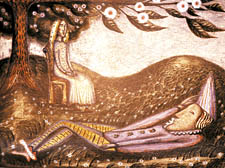|
|
 |
| |

The Sleeping Fool by Cecil Collins, 1943 |
Designs and visionaries
Piers Plowright finds two uplifting books that celebrate artists who believed in making everything they produced beautiful
Design: Harold Curwen & Oliver Simon at the Curwen Press.
By Peyton Skipwith and Brian Webb.
In Celebration of Cecil Collins – Visionary Artist and Educator.
Edited by Nomi Rowe.
THERE are some books that are simply a delight to hold and look at and here are two of them. Both are about artists/ craftsmen and what they made and both are about men who believed in making everything they produced beautiful. After all, as Peyton Skipwith points out in his Design text, the creation of the “Book Beautiful” was one of the driving ideals of the Arts and Crafts Movement, which lay behind the precision and elegance Harold Curwen brought to the press founded by his grandfather.
And for visionary painter and teacher, Cecil Collins – there’s a room devoted to him at Tate Britain at the moment – painting was a kind of pilgrimage in search of a lost paradise. So it seems a good moment, 20 years after Collins’s death, and 60 years after Curwen’s, with our society in particular need of the comforts that art and literature can bring, for these two books to appear.
When Harold “Mr Bubbles” Curwen joined the family firm in 1908, he found a high-minded, left-leaning, and painstaking press, whose main income came from music publishing.
What he didn’t find was any sense of “vision” and Harold, an endearing mix of jolly scoutmaster and forward-looking craftsman (he’d studied calligraphy under master calligrapher and typographer, Edward “London Underground” Johnston) soon changed all that. By the outbreak of the First World War, the Curwen Press was using the latest technology to print beautiful, coloured images as book illustrations, and for catalogues, show cards, and pamphlets.
In the atmosphere of relief and euphoria that followed the Armistice, “Mr Bubbles” led the Press in an onslaught on all that was dull and timid: GET THE SPIRIT OF JOY INTO YOUR PRINTED THINGS shouted a CP handout, and artists like Claud Lovat Fraser, Ruth Vaughan-Stevens, and Albert Rutherston put the message into practice.
Then, in 1919, a young Jewish would-be artist, on the run from the family cotton business in Manchester, climbed aboard. His name was Oliver Simon, his uncle was William Rothenstein, Principal of the Royal College of Art, and his arrival transformed Curwen from a fledgling into a golden eagle.
Between 1922 and 1932, the Press, with offices in Plaistow and the West End, became one of the focal points of British design and an international meeting house for anyone interested in typography or printing. The story of that flowering and beyond into the 1960s and 1970s is the subject of this finely produced book, designed by master-printer Brian Webb and written by fine-art consultant, critic and historian Peyton Skipwith.
Cecil Collins would have approved of the Curwen Press. He certainly believed in “the spirit of joy” and it was at William Rothenstein’s Royal College of Art in 1927 that this largely self-taught Plymouth boy began to find his own “voice”.
For the next 60 years he went his own way, impressed but not seduced by Surrealism, intrigued but not controlled by Cubism, moved by dance, music, science, myth and religion, to create his own magical world of clowns, kings and angels.
He believed, as Hampstead-based artist and teacher Nomi Rowe makes clear in her introduction to this new book, that art had a sacred purpose to serve and awaken each person’s inner divinity. This is not a formal portrait of the man, but a word mosaic, “a collage of undated snapshots”, by friends, colleagues and pupils – he was a brilliant if very unorthodox teacher – that bring to life a warm, spiky (you didn’t mention Francis Bacon or Andy Warhol to Collins), funny, affectionate (his marriage to fellow artist Elisabeth Ramsden was deep, important, and lasted his lifetime), sometimes infuriating (curating an exhibition of his work was a nightmare as he kept changing his mind about what should be shown and how it should be hung) and, in the end, inspiring, man.
This sumptuously illustrated book is worth the money: just gaze at one of Collins’s holy fools or mysterious ships. Paradise isn’t far away.
|
|
|
 |
 |
|
 |
|


